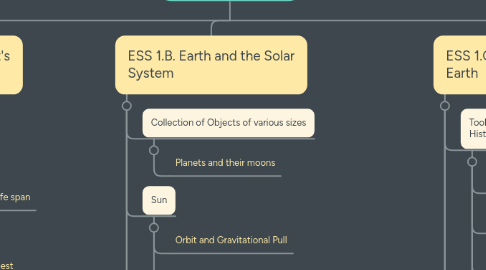
1. ESS 1.A. The Universe and it's Stars
1.1. Sun
1.1.1. Medium size
1.1.2. Half way through expected life span
1.1.3. Approx 10 Billion years
1.1.4. Biggest star because it's closest
1.1.5. One of 200 Billion stars in Galaxy
1.2. Stars
1.2.1. Nuclear Fusion
1.2.2. Iron
1.2.3. enegery
1.2.4. star light
1.2.5. Super Nova Stage
1.2.5.1. Explode
1.2.5.1.1. Material from explosion forms younger stars
1.2.6. Sequence of Developmental Stages
1.2.6.1. Formed
1.2.6.2. Evolved in Size
1.2.6.3. Evolved in Mass
1.2.6.4. Evolved in Brightness
1.2.6.5. Eventually Burn Out
1.2.7. Range in size & Distance
1.2.8. Light spectra
1.2.9. Brightness
1.3. Big Bang
1.3.1. Hydeogen
1.3.2. Helium
1.4. Milky Way Galaxy
1.4.1. One of many in the Universe
1.5. Patterns can be observed, described, predicted & explained with models
1.5.1. Sun
1.5.2. Moon
1.5.3. Stars
2. ESS 1.B. Earth and the Solar System
2.1. Collection of Objects of various sizes
2.1.1. Planets and their moons
2.2. Sun
2.2.1. Orbit and Gravitational Pull
2.2.2. holds planets in place
2.3. Formed by
2.3.1. Disk of dust and gas
2.3.2. drawn together by gravity
2.4. Predictable patterns of movement
2.4.1. Earth
2.4.1.1. moon
2.4.1.1.1. shines light that is reflected from the sun
2.4.1.1.2. monthly orbit around earth
2.4.1.1.3. Phases
2.4.1.2. Axis
2.4.1.2.1. tilted
2.4.1.2.2. causes seasons
2.4.1.3. rotation
2.4.1.3.1. Day
2.4.1.3.2. Night
2.4.1.3.3. month
2.4.1.3.4. year
2.4.1.4. gradual changes in orbit
2.4.1.4.1. altered intensity and distribution of sun light
2.4.1.5. Gravity holds
2.4.2. planets
2.4.2.1. Motion around the sun is explained by Kepler's laws
2.4.2.1.1. Kepler's 3 Impericial Laws
2.4.3. Solar Eclipse
2.4.4. Lunar Eclipse
2.5. Gravitational Forces
2.5.1. Holds the Earth in place
2.5.2. Holds the Moon in Earth's orbit
2.5.3. Causes patterns of Ocean tides
2.6. Laws of Conservation
3. ESS 1.C. The History of Planet Earth
3.1. Tools Scientist use to reconstruct Earth's History
3.1.1. Structure
3.1.2. Sequence
3.1.3. Properties of Rocks
3.1.3.1. Rocks
3.1.3.1.1. Rock Layers
3.1.3.1.2. shows periods of past extinctions
3.1.3.1.3. shows volcanic activity
3.1.4. Sediments
3.1.5. Fossils
3.1.5.1. Analysis records are used to establish relative ages
3.1.5.2. Location of Fossils help reveal age of rocks
3.1.5.3. Help geologist decipher the history of landforms
3.1.6. Locations of current and past:
3.1.6.1. Ocean Basins
3.1.6.2. Lakes
3.1.6.3. Rivers
3.2. Meteorites
3.3. Asteriods
3.4. Study of other Planets to help illuminate aspects of Earth's history
3.4.1. those that exhibit similar features as volcanism
3.4.2. Meteor impacts
3.5. Intervals of time
3.5.1. Eras
3.5.2. Periods
3.5.3. Epochs
3.6. Major Historical Events
3.6.1. Formation of Mountain Chains
3.6.2. Ocean Basins
3.6.3. Volcanic Activity
3.6.4. Evolution and Extinction of living organisms
3.6.5. periods of massive glaciation
3.6.6. Development of watersheds and rivers

